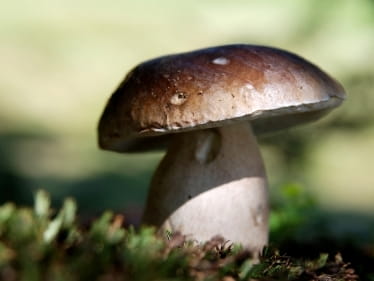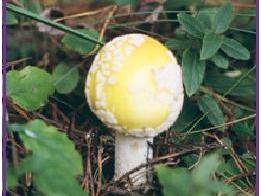Wild Mushroom Warning Mushroom Poisoning: Don't Invite "The Death Angel" to Dinner

The Bottom Line
There are old mushroom hunters, and there are bold mushroom hunters. There are no old, bold mushroom hunters.

The Full Story
Wild mushrooms are abundant in many areas of the country, especially after a rainy spell. Some of these mushrooms are dangerous to eat; a few can even kill you. One type of mushroom, Amanita virosa, is so dangerous that it is called "the death angel".
How can you tell the difference between an edible wild mushroom and a poisonous one? Unless you are very experienced in mushroom identification, you can't!! There are a lot of mushroom look-alikes. Poison Control help many people with mushroom poisoning. Almost all of them were sure they were picking a safe mushroom.
It is NEVER safe to eat a wild mushroom unless a mushroom identification expert says so. It is important to watch children playing outdoors so they don't eat mushrooms; after all, to a child it just looks like dinner!
How does a mushroom expert identify a mushroom? There are many things to examine:
- shape, color, and texture of the cap;
- presence and appearance of gills or pores under the cap;
- spore color;
- appearance of the stalk, including the very bottom of the stalk under the dirt and whether it changes color when bruised or cut;
- whether the cap is attached to the stalk;
- whether the mushroom is growing singly, in a cluster, or in a circle with other mushrooms;
- what the mushroom is growing on.
Symptoms of mushroom poisoning vary with the type of mushroom eaten. Many wild mushrooms will cause vomiting and diarrhea; that could lead to dehydration and an emergency room visit. Others can interact with alcohol to cause severe stomach upset, headache, and high blood pressure. Some can cause hallucinations and coma. A few cause no effects right away, but can damage the liver; a liver transplant may be necessary to survive.
Here are some safety tips for wild mushrooms:
- NEVER pick and eat wild mushrooms unless they've been identified by an expert!
- Look-alike mushrooms can fool you. Learning how to identify mushrooms in one part of the country or another country is not reliable for identifying mushrooms in another area.
- Cooking doesn't make a poisonous mushroom safe. In fact, you can be poisoned by breathing in the cooking fumes from some poisonous mushrooms.
- Even non-poisonous mushrooms can cause unpleasant reactions in people who are sensitive to them.
- Symptoms from eating poisonous mushrooms can be delayed for many hours.
If you think that someone has eaten a wild mushroom, call Poison Control right away at 1-800-222-1222. Poison specialists will tell you exactly what to do. They will work with mycologists (mushroom identification experts) to find out what kind of mushroom it is. They will also work with the emergency room staff so you can get proper treatment.
Remember: There are old mushroom hunters, and there are bold mushroom hunters. There are no old, bold mushroom hunters!
Rose Ann Gould Soloway, RN, BSN, MSEd, DABAT emerita
Clinical Toxicologist
Poisoned?
CALL 1-800-222-1222
Prevention Tips
- NEVER pick and eat wild mushrooms unless they've been identified by an expert!
- Look-alike mushrooms can fool you. Learning how to identify mushrooms in one part of the country or another country is not reliable for identifying mushrooms in another area.
- Cooking doesn't make a poisonous mushroom safe. In fact, you can be poisoned by breathing in the cooking fumes from some poisonous mushrooms.
- Even non-poisonous mushrooms can cause unpleasant reactions in people who are sensitive to them.
- Symptoms from eating poisonous mushrooms can be delayed for many hours.
This Really Happened
A 50-year-old woman picked wild mushrooms and ate them for lunch. About 12 hours later she developed vomiting and diarrhea that lasted all night. Two days later she became unresponsive with dilated pupils and labored breathing and was taken to the nearest emergency room. A breathing tube was placed and she was connected to a ventilator. The emergency physician called Poison Control for advice on treatment of mushroom poisoning. A mycologist (a biologist specializing in the study of fungi such as mushrooms) was consulted. The mushrooms that the patient ate were of a highly poisonous variety, Amanita phalloides. This type of mushroom contains poisons called amatoxins. The patient was in liver and kidney failure.
Working with the patient's physicians and the mycologist, the poison specialist recommended silymarin (a substance from the milk thistle plant, confirmed in experimental models to inhibit entry of amatoxins into liver cells); N-acetylcysteine (NAC) (an antidote that may offer some liver protection in some mushroom poisonings); and Penicillin G (possibly inhibits amatoxin uptake into liver cells). The patient was treated with silymarin for several days starting 2 days after she ate the mushrooms, as well as with hemoperfusion (the patient's blood is passed over a special filter that removes toxins). In addition her gallbladder was drained, a newer procedure for removal of poisons from the body. She was placed on NAC 3 days after ingestion. She did not receive Penicillin G after much discussion among her physicians, the poison specialist and the mycologist.
Despite highly aggressive treatment, the patient's blood pressure dropped very low even on maximum doses of drugs called vasopressors. Six days after the mushroom ingestion, she was bleeding internally due to liver damage and was receiving blood products. Eight days after she ate the mushrooms, the patient had a liver biopsy to determine her eligibility for liver transplant and she was placed on the transplant list. She continued to require a ventilator to breathe, remained on hemoperfusion, and developed pneumonia. Two weeks after eating the mushrooms the patient died.
For More Information
References
Poisoned?
CALL 1-800-222-1222
Prevention Tips
- NEVER pick and eat wild mushrooms unless they've been identified by an expert!
- Look-alike mushrooms can fool you. Learning how to identify mushrooms in one part of the country or another country is not reliable for identifying mushrooms in another area.
- Cooking doesn't make a poisonous mushroom safe. In fact, you can be poisoned by breathing in the cooking fumes from some poisonous mushrooms.
- Even non-poisonous mushrooms can cause unpleasant reactions in people who are sensitive to them.
- Symptoms from eating poisonous mushrooms can be delayed for many hours.
This Really Happened
A 50-year-old woman picked wild mushrooms and ate them for lunch. About 12 hours later she developed vomiting and diarrhea that lasted all night. Two days later she became unresponsive with dilated pupils and labored breathing and was taken to the nearest emergency room. A breathing tube was placed and she was connected to a ventilator. The emergency physician called Poison Control for advice on treatment of mushroom poisoning. A mycologist (a biologist specializing in the study of fungi such as mushrooms) was consulted. The mushrooms that the patient ate were of a highly poisonous variety, Amanita phalloides. This type of mushroom contains poisons called amatoxins. The patient was in liver and kidney failure.
Working with the patient's physicians and the mycologist, the poison specialist recommended silymarin (a substance from the milk thistle plant, confirmed in experimental models to inhibit entry of amatoxins into liver cells); N-acetylcysteine (NAC) (an antidote that may offer some liver protection in some mushroom poisonings); and Penicillin G (possibly inhibits amatoxin uptake into liver cells). The patient was treated with silymarin for several days starting 2 days after she ate the mushrooms, as well as with hemoperfusion (the patient's blood is passed over a special filter that removes toxins). In addition her gallbladder was drained, a newer procedure for removal of poisons from the body. She was placed on NAC 3 days after ingestion. She did not receive Penicillin G after much discussion among her physicians, the poison specialist and the mycologist.
Despite highly aggressive treatment, the patient's blood pressure dropped very low even on maximum doses of drugs called vasopressors. Six days after the mushroom ingestion, she was bleeding internally due to liver damage and was receiving blood products. Eight days after she ate the mushrooms, the patient had a liver biopsy to determine her eligibility for liver transplant and she was placed on the transplant list. She continued to require a ventilator to breathe, remained on hemoperfusion, and developed pneumonia. Two weeks after eating the mushrooms the patient died.
